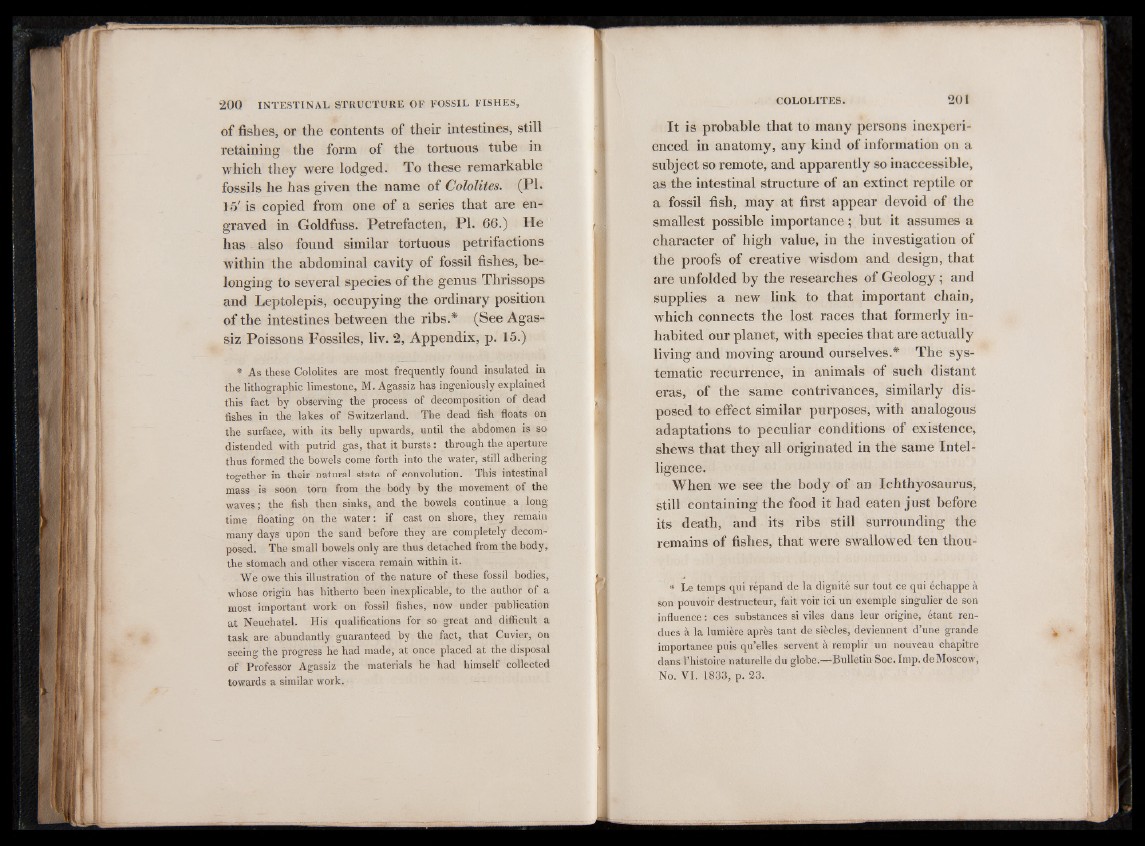
of fishes, or the contents of their intestines, still
retaining the form of the tortuous tube in
which they were lodged. To these remarkable
fossils he has given the name of Cololites. (PI.
15' is copied from one of a series that are engraved
in Goldfuss. Petrefacten, PI. 66.) He
has also found similar tortuous petrifactions
within the abdominal cavity of fossil fishes, belonging
to several species of the genus Thrissops
and Leptolepis, occupying the ordinary position
of the intestines between the ribs.* (See Agassiz
Poissons Fossiles, liv. 2, Appendix, p. 15.)
* As these Cololites are most frequently found insulated in
the lithographic limestone, M. Agassiz has ingeniously explained
this fact by observing the process of decomposition of dead
fishes in the lakes of Switzerland. The dead fish floats on
the surface, with its belly upwards, until the abdomen is so
distended with putrid gas, that it bursts : through the aperture
thus formed the bowels come forth into the water, still adhering
together in their natural state of convolution. This intestinal
mass is soon torn from the body by the movement of the
waves ; the fish then sinks, and the bowels continue a longtime
floating on the water : if cast on shore, they remain
many days upon the sand before they are completely decomposed.
The small bowels only are thus detached from the body,
the stomach and other viscera remain within it.
We owe this illustration of the nature of these fossil bodies,
whose origin has hitherto been inexplicable, to the author of a
most important work on fossil fishes, now under publication
at Neuchâtel. His qualifications for so great and difficult a
task are abundantly guaranteed by the fact, that Cuvier, on
seeing the progress he had made, at once placed at the disposal
of Professor Agassiz the materials he had himself collected
towards a similar work.
It is probable that to many persons inexperienced
in anatomy, any kind of information on a
subject so remote, and apparently so inaccessible,
as the intestinal structure of an extinct reptile or
a fossil fish, may at first appear devoid of the
smallest possible importance; but it assumes a
character of high value, in the investigation of
the proofs of creative wisdom and design, that
are unfolded by the researches of Geology; and
supplies a new link to that important chain,
which connects the lost races that formerly inhabited
our planet, with species that are actually
living and moving around ourselves.* The systematic
recurrence, in animals of such distant
eras, of the same contrivances, similarly disposed
to effect similar purposes, with analogous
adaptations to peculiar conditions of existence,
shews that they all originated in the same Intelligence.
When we see the body of an Ichthyosaurus,
still containing the food it had eaten just before
its death, and its ribs still surrounding the
remains of fishes, that were swallowed ten thou-
* Le temps qui répand de la dignité sur tout ce qui échappe à
son pouvoir destructeur, fait voir ici un exemple singulier de son
influence : ces substances si viles dans leur origine, étant rendues
à la lumière après tant de siècles, deviennent d’une grande
importance puis qu’elles servent à remplir un nouveau chapitre
dans l’histoire naturelle du globe.—Bulletin Soc. Imp.deMoscow,
No. VI. 1833, p. 23.